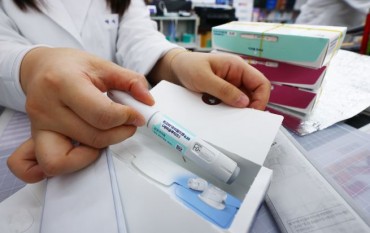
Research suggests that the younger the children are, the more environmental pollutants such as heavy metals are concentrated in their bodies. (Image : Yonhap)
SEJONG, Sept.17 (Korea Bizwire) – Research suggests that the younger the children are, the more environmental pollutants such as heavy metals are concentrated in their bodies.
A study was conducted by the National Institute of Environmental Research over the past three years (from 2012 to 2014), on 2,397 children and youth aged between three and 18. The concentrations of nine environmental pollutants within the bodies of the subjects of the study were investigated, and the results showed that the younger children were, the higher the concentrations of harmful substances were.
Among the study’s participants were 577 infants (ages 3 to 5), 914 elementary school students (ages 6 to 11) and 906 teenagers (ages 12 to 18). It was the first attempt made to investigate the concentration of pollutants in the bodies of infants.
The concentrations of nine substances were checked, including heavy metals such as lead, mercury and cadmium. Suspected endocrine disruptors like bisphenol-A and five different types of phthalate were also included.
The blood lead concentration (㎍/㎗) of infants was 1.34, while researchers discovered concentrations of 1.26 among elementary students and 1.11 among teenagers. One㎍ is a microgram, and one㎗ is a tenth of a liter. So, 1㎍/㎗ (1 microgram per deciliter) means that there is a microgram of the substance in every tenth of a liter of blood.
The urine concentration of bisphenol-A (㎍/ℓ) was 2.33 among infants, 1.5 among elementary students and 1.31 among teenagers. Bisphenol-A is a typical endocrine disrupting substance which is known to hinder internal secretion.
However, the concentration of mercury turned out to be higher among elementary school students (1.93㎍/ℓ). Teenagers had similar levels (1.91), and infants showed the lowest concentration level (1.64).
The National Institute of Environmental Research says that the behavior characteristics of infants may have influenced the accumulation of environmental pollutants. Infants have a tendency to put anything that gets in their hands into their mouth. Also, the food intake per weight for infants is two to three times higher than adults. This means that even if the same amount of food is consumed, concentration levels could be higher.
Only mercury, which is not eliminated from the body, turned out to have a higher concentration among children and teenagers.
Researchers say that if infants are exposed to environmental pollutants, the exposure could influence their health for life. They emphasize that measures should be taken to reduce exposure by providing an eco-friendly nurturing environment, and using eco-friendly goods.
By Lina Jang (linagang@koreabizwire.com)






